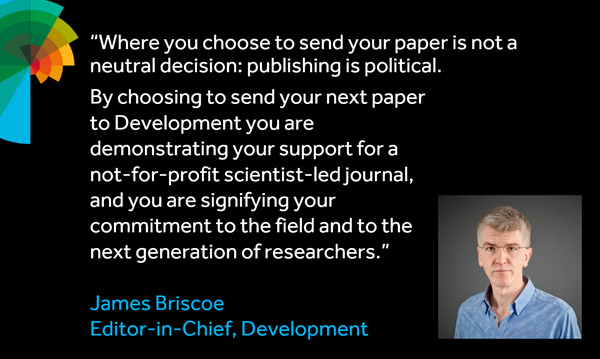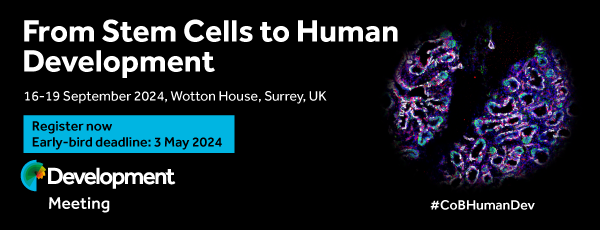Issues
-
Cover image
Cover Image

Cover: An adult of the basal echinoid (cidaroid) Prionocidaris baculosa. The endomesoderm gene regulatory network (GRN) in cidaroids appears to preserve the ancestral state of echinoids and provides a valuable model for understanding the diversification of the early developmental GRN. See Research article by Yamazaki et al. (dev182139). Picture credit: Makoto Urata (Kanazawa University).
- PDF Icon PDF LinkTable of contents
- PDF Icon PDF LinkIssue info
RESEARCH HIGHLIGHTS
INTERVIEWS
MEETING REVIEW
On growth and force: mechanical forces in development
Summary: This Meeting Review summarises the main results presented at the EMBO/EMBL Symposium ‘Mechanical Forces in Development’ held in Germany in July 2019.
PRIMER
Model systems for regeneration: the spiny mouse, Acomys cahirinus
Summary: This Primer summarizes the studies using the spiny mouse as a mammalian model for regeneration, its phylogenetic position, historical perspective and what we have learnt about principles of regeneration from this new model.
REVIEW
The origin of animal body plans: a view from fossil evidence and the regulatory genome
Summary: Comparative genomic and developmental studies provide a window into the origin and early history of animal evolution, particularly the role played by changes in the regulatory genome.
STEM CELLS AND REGENERATION
Sp2 regulates late neurogenic but not early expansive divisions of neural stem cells underlying population growth in the mouse cortex
Highlighted Article: Specificity protein 2 conditionally deleted mice reveal mechanistic differences between the early expansive and later neurogenic periods of cortical development.
Drosophila adult muscle precursor cells contribute to motor axon pathfinding and proper innervation of embryonic muscles
Summary: In Drosophila embryos, muscle stem cells represent spatial landmarks for navigating motor axons and are required for proper innervation of lateral muscles.
RESEARCH REPORT
Disruption of dmrt1 rescues the all-male phenotype of the cyp19a1a mutant in zebrafish – a novel insight into the roles of aromatase/estrogens in gonadal differentiation and early folliculogenesis
Summary: Genetic analysis in zebrafish shows that estrogens produced by Cyp19a1a induce ovarian differentiation by suppressing Dmrt1 expression; however, they play little role in controlling the subsequent early folliculogenesis.
RESEARCH ARTICLES
pmar1/phb homeobox genes and the evolution of the double-negative gate for endomesoderm specification in echinoderms
Summary: The evolution of the developmental gene regulatory network, including the sea urchin-specific homeobox gene pmar1, provides an exceptional model for understanding how early developmental processes evolved.
Maternal Larp6 controls oocyte development, chorion formation and elevation
Summary: Genome-edited larp6a and larp6b double-knockout zebrafish appear morphologically and behaviourally wild type and are fertile. Larp6 proteins are, however, required maternally for normal oocyte development and chorion formation and elevation.
Oscillatory expression of Hes1 regulates cell proliferation and neuronal differentiation in the embryonic brain
Highlighted Article: Dampened Hes1 oscillations reduce the proliferation of neural progenitor cells and accelerate neuronal differentiation, suggesting functional significance of robust Hes1 oscillations in efficient proliferation and maintenance of neural progenitor cells.
Oestrogen in the chick embryo can induce chromosomally male ZZ left gonad epithelial cells to form an ovarian cortex that can support oogenesis
Summary: Cell-autonomous sex identity does not apply to chicken ovarian cortex development. The gonadal epithelium responds to oestrogen via ERα and drives cortex formation independently of the medulla's phenotypic sex.
Optic cup morphogenesis requires neural crest-mediated basement membrane assembly
Highlighted Article: Multidimensional imaging and computational analyses in zebrafish reveal that optic cup morphogenesis is dependent upon neural crest-derived nidogens, which modulate extracellular matrix assembly.
Cyp26b1 is an essential regulator of distal airway epithelial differentiation during lung development
Highlighted Article: Loss of Cyp26b1 results in neonatal lethality due to failure of distal lung epithelial differentiation, with increased AT2 and decreased AT1 cell types.
Dendrites with specialized glial attachments develop by retrograde extension using SAX-7 and GRDN-1
Summary: Sensory dendrites attach at the nose of a C. elegans embryo and stretch out during embryo elongation. Their tips are anchored by SAX-7/L1CAM acting in neurons and glia, and by GRDN-1/CCDC88C acting in glia.
Laminin-binding integrins are essential for the maintenance of functional mammary secretory epithelium in lactation
Summary: The p53 pathway is involved in the control of mammary cell proliferation and survival downstream of laminin-binding integrins, revealing the essential role of cell interactions with laminin for lactogenic differentiation.
Notch signalling regulates epibranchial placode patterning and segregation
Summary: Notch signalling regulates the rostral-caudal patterning and commitment of the epibranchial placodal region into repeated Vgll2+/Irx5+ and Sox2+/Fgf3+/Etv5+ domains along the pharyngeal clefts, leading to the formation of individual placodes.
TECHNIQUES AND RESOURCES
Germline development in rat revealed by visualization and deletion of Prdm14
Summary: Genetic modification of Prdm14, a unique germ cell specifier, in rat allows rat germline specification/development to be traced and to be compared across mammals.
A genetic system for tissue-specific inhibition of cell proliferation
Highlighted Article: Inducible p21-GFP transgenic mice enable experimentally induced permanent cell cycle arrest and genetic marking of specific cell lineages of interest, allowing the effects of cell proliferation on cell fate plasticity to be studied.
Call for papers: Uncovering Developmental Diversity

Development invites you to submit your latest research to our upcoming special issue: Uncovering Developmental Diversity. This issue will be coordinated by our academic Editor Cassandra Extavour (Harvard University, USA) alongside two Guest Editors: Liam Dolan (Gregor Mendel Institute of Molecular Plant Biology, Austria) and Karen Sears (University of California Los Angeles, USA).
Choose Development in 2024

In this Editorial, Development Editor-in-Chief James Briscoe and Executive Editor Katherine Brown explain how you support your community by publishing in Development and how the journal champions serious science, community connections and progressive publishing.
Journal Meeting: From Stem Cells to Human Development

Register now for the 2024 Development Journal Meeting From Stem Cells to Human Development. Early-bird registration deadline: 3 May. Abstract submission deadline: 21 June.
Pluripotency of a founding field: rebranding developmental biology

This collaborative Perspective, the result of a workshop held in 2023, proposes a set of community actions to increase the visibility of the developmental biology field. The authors make recommendations for new funding streams, frameworks for collaborations and mechanisms by which members of the community can promote themselves and their research.
Read & Publish Open Access publishing: what authors say

We have had great feedback from authors who have benefitted from our Read & Publish agreement with their institution and have been able to publish Open Access with us without paying an APC. Read what they had to say.



